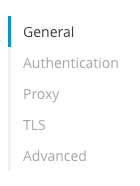@Parameter
@Example("0.0.0.0")
private String port;Customizing the Parameters UI
The SDK provides a set of annotations used for customizing many aspects of the UI and UX.
@Example
Sometimes it is helpful to provide a simple example with the values a parameter can take.
That parameter will be rendered as:

@Summary
@Summary is for a short description of the purpose of a parameter.
For example, this description can be used in Studio as the text to be displayed while hovering over the parameter:
@Parameter
@Optional(defaultValue = "SECONDS")
@Summary("Time unit to be used in the Connection Timeout")
private TimeUnit connectionTimeoutUnit;That parameter will be rendered like this:

@Placement
This annotation enables you to configure these settings:
-
A relative order within the group in which the parameter is defined. The value is relative in the sense that the element with order
10is above one with value25. -
A tab, which is a graphical way to group parameters together. This attribute specifies the name of the tab in which the parameter should be displayed. It uses a default of "General" is no name is specified. To display more than one parameter or field in the same the tab, the value for the tab should be the same for all of them.
In the following example, foo and bar will be grouped into the same tab named Advanced, while foobar will be the only parameter in the default tab.
@Parameter
@Placement(order = 1, tab="Advanced")
private String foo;
@Parameter
@Placement(order = 2, tab="Advanced")
private String bar;
@Parameter
private String foobar;foo and bar parameters will be rendered in a new tab "Advanced" like this:

@Text
Indicates that a parameter supports a multi-line string input in the UI. This annotation also affects the DSL, making the annotated parameter a child element with the text as the content of the element.
Note that this annotation should only be used in parameters of String type.
@Parameter
@Optional
@Text
@DisplayName("SQL Query Text")
private String sql;In Studio, the @Text will be rendered like this:

@Text also affects the DSL of the element that contains the parameter. using it creates a child element that accepts CDATA content. For example, assume that you have this operation:
public void execute(String message) { ... }The DSL for the operation above looks like this:
<example:execute message="This is a pretty inline message!"/>This example annotates the message operation parameter with @Text:
public void execute(@Text String message) { ... }So the corresponding DSL looks like this:
<example:execute>
<example:message>
<![CDATA[ This is a pretty CDATA message! ]]>
</example:message>
</example:execute>@Path
Marks a parameter as a path to either a file or a directory. This parameter will be displayed in the UI as a file-picker field.
Note that this annotation should only be used in parameters of String type.
This annotation carries information about:
-
type: Whether the path points to a directory, a file, or any of those. -
acceptsUrls: Whether the path parameter supports URLs. -
acceptedFileExtensions: A list of file extensions this parameter can handle.
This example accepts a .txt resource that can be remote:
@Parameter
@Path(type = FILE, acceptedFileExtensions = "txt", acceptsUrls = true)
private String resourcePath;@Password
Indicates that the parameter needs to be masked when it is populated from the UI.
Note that this annotation should only be used in parameters of String type.

Putting It All Together
This example uses features explained above:
@Parameter
@Placement(order = 3, tab="Additional information")
@Example("My name is Max the Mule and I love MuleSoft!")
@DisplayName("User biography")
@Summary("Information related to the user\'s life")
@Text
private String biography;@ClassValue
Available since version 1.1
Indicates that a parameter is a reference to a class name.
Note that this annotation should only be used in parameters of String type.
Besides hinting to the tooling that the parameter is a class, it also allows you to specify restrictions on the classes that can be
referenced. It can indicate that the assigned values must extend or implement (extendsOrImplements) specific classes or interfaces.
Consider a Database connector that requires the end user to provide the class name of the JDBC Driver to be used, for example:
@Parameter
@ClassValue(extendsOrImplements = "java.sql.Driver")
private String driverClassName;


